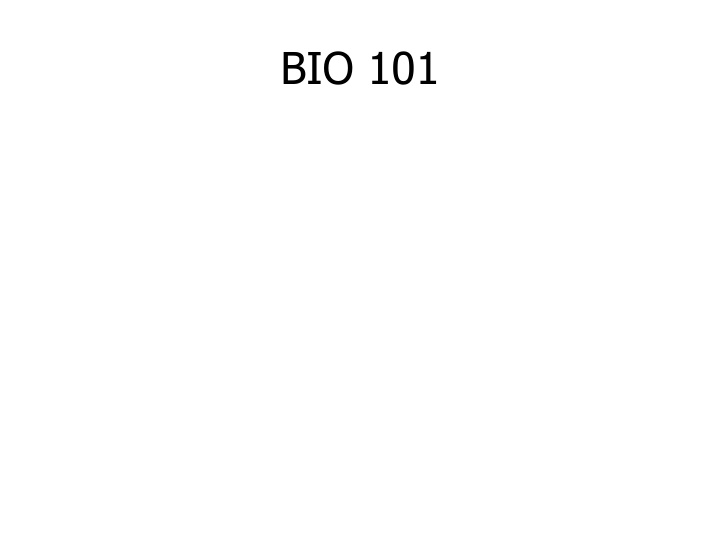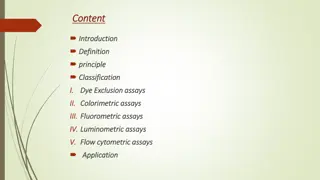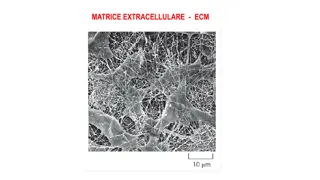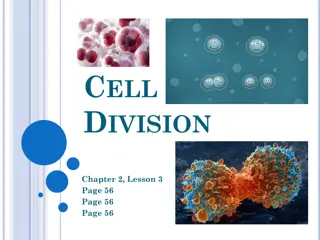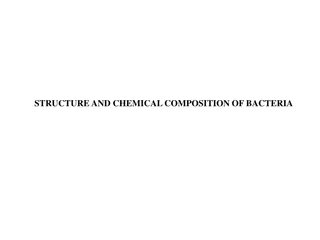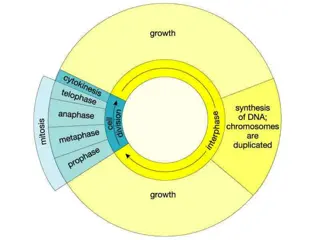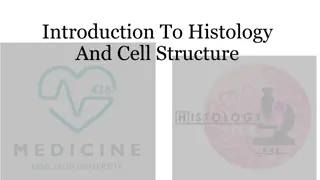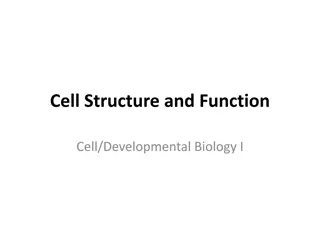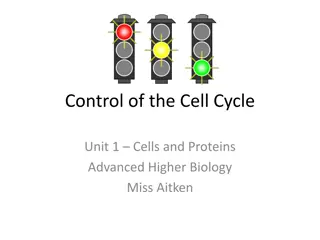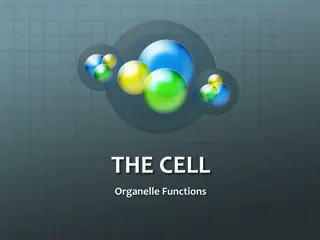Exploring Cell Structures and Functions
Organisms, from large animals to tiny microbes, are composed of cells with common structural features. The unifying cell theory was proposed by Schleiden and Schwann in the 19th century, highlighting the importance of cells in all living organisms. Cells contain protoplasm with various organelles, each serving specialized functions. The structure and functions of cells, such as nerve cells and epithelial cells, involve intricate membranes and organelles like the endoplasmic reticulum. Understanding these components is essential to grasp the complexity of cellular biology.
Download Presentation

Please find below an Image/Link to download the presentation.
The content on the website is provided AS IS for your information and personal use only. It may not be sold, licensed, or shared on other websites without obtaining consent from the author.If you encounter any issues during the download, it is possible that the publisher has removed the file from their server.
You are allowed to download the files provided on this website for personal or commercial use, subject to the condition that they are used lawfully. All files are the property of their respective owners.
The content on the website is provided AS IS for your information and personal use only. It may not be sold, licensed, or shared on other websites without obtaining consent from the author.
E N D
Presentation Transcript
organisms, large and small, plant and animal, fish and fowl, man and microbe, are made up of cells. All cells are basically similar to each other, having many structural features in common. Organisms may be composed of only one cell, when we describe them as being unicellular, or of many cells when we say they are multicellular.
structures, thinking that they resembled the unadorned cells occupied by the monks. In 1838 Mathias Schleiden, a German botanist, announced that all plant tissues were composed of cells. A year later one of his countrymen, Theodor Schwann, described animal cells as being similar to plant cells. Schleiden and Schwann are thus credited with the unifying cell theory. Some 20 years after the announcements of Schleiden
as protoplasm, consisting of the jelly like cytoplasm (cyto-cell, plasma thing) and various structures collectively known as organelleles, including the membrane, bound nucleus. Each organelles represents a highly specialized compartment or submodule in which particular functions of the cell are localized.
as nerve cells, the plasma membrane also is involved in intercellular communication in other cells, such as intestinal epithelium, the plasma membrane is modified into numerous, small, finger like projection called microvilli that increase the surface area of the cell. Chemically, the membrane consists of lipid (fatty material)and protein.
smooth along their outer surface. However, sometimes the outer surface is studied with small particles called ribosomes, and in this case the endosplasmic reticulum has a coarse appearance and is spoken of as rough. The R.E.R. is found with greater frequency and abundance in cells which are actively synthesizing protein. The manufacture of proteins in the cell is associated with the ribosomes, which are
the cisternea of the |E. R. apparently function as roots for transport of certain substances within the cell. In some cases, the ER accumulates large masses of protein and acts in a storage capacity.
digestive enzymes that remain in the cell that produce them. Such vesicles are called Lysosomes (literally loosening body , a body capable of causing lysis, or disintegration). The enzymes they contain are involved in the breakdown of foreign materials, including bacteria engulfed by the cells. Lysosomes are also capable of breaking down injured or diseased cells and worn-out cellular
The outer membrane is smooth, whereas the inner membrane is folded into numerous platelike projections called cristae. These characteristics features make mitochondria easy to identify among the organelles. They are often called powerhouse of the cell because enzymes located on the cristae carry out the energy- yielding steps of aerobic metabolism. ATP, the most
They are disc-shaped bodies containing a green pigment called chlorophyll. The complex chemical processes of photosynthesis take place in the chloroplast where the energy of sunlight is trapped and utilized for the synthesis of complex organic materials from simple inorganic molecules.
two parts: a fluid matrix (stroma) surrounding a complex membrane. The membrane system generally consists of a series of multilayered fluid-fluid discs (grana) resembling a stack of coins and a system of closed flat sacs (lamellae) extending throughout the chloroplast and connecting the grana.
leucoplasts (white or colourless bodies). Chloroplasts belong to the chromoplasts group. Other kinds of chromoplasts give many flowers and leaves their colours or yellow, orange or red. Leucoplasts serve as food storage deposits for the cell and contain oil, starch grains and protein.
periphery of the cell, and there it remains as a thin layer closely pressed against the plasma membrane. The vacuole of plant cells contains primarily water and a watery of other substances together called cell sap, because cell sap has a higher osmotic pressure than the external medium, water moves into the cell and the cell becomes turgid. It does not burst because it is surrounded by a rigid cell wall. The turgid nature of
include amino acids, proteins, salts, sugars and the red pigment anthocyanin. The red colour of roses, and red onions is due to the presence of anthocynanims in their vacuolar fluid. Vacuoles are formed in animal cells during the processes of pinocytosis and phagocytosis.
Microtubules are capable of rapid assembly and disassembly and are primarily composed of the protein tubulin. Microtubules are the structural framework of cilia and flagella; in the mitotic spindle, microtubules act to move the chromosomes during cell division.
with the inner surface of the plasma membrane where they occur in bundles and sheets. The muscle-like contractions of microfilaments are involved in cell movement and changes of cell shape and in cytoplasmic streaming.
Centrioles are not indispensable during cell division, however, the cells of higher plants contain no centrioles, and yet are still capable of dividing properly. The centrioles under the electronmicroscope consist of a circlet of nine microtubules, each of which is further subdivided into three smaller tubules. Centrioles are self- replicating.
appendages are called cilia and the whiplike appendages are called flagella. The cells of the fallopian tubes of the female (human) reproductive system and the cells of the trachea are lined with cilia. Spermatozoa produced in the testes of the human male are motile because of the activity of their lashing tails, which are really flagella.
this is a ring of nine pairs of microtubules surrounding two central tubules. The basic structure of these organelles is often referred to as a nine-plus-two arrangement of tubules. Only the cylinder of nine tubules continues below the cell surface and there it forms the basal body, which appears structurally identical to the centriole. The ability to move rhythmically or to beat is an inherent property of cilia and
(nucleolus). The chromatin is a complex of DNA and instore and nonhistone protein and carries the genetic information of the cell. Nucleoli are specialized parts of certain chromosomes that carry multiple copies of the DNA information to synthesize ribosomal RNA. After transcription from the nucleolar DNA, the ribosomal RNA combines with several different proteins to form a ribosome
cells: the prokaryotic cell typical of bacteria and blue-green algae (cynabacteria) and the eukaryotic cell found in all other organisms, plant and animal.
which a more or less rigid cell wall and a jellylike, mucilaginous capsule or sheath are present. They contain a single chromosome comprised of a single, large molecule of DNA not located in a membrane-bound nucleus, but found in a nuclear region, or nucleoid. The DNA is not complexed with histones proteins, and prokaryotes lack membraneous organelles such as mitochondria,
cell is bounded by a plasma membrane, to which, in the case of plant cells, an outer wall of cellulose and other materials have been added. The hereditary material is enclosed in a membrane-bound nucleus and is segmented into complex nucleoprotein bodies or chromosomes, the number of which is characteristic for each species.
Table : The Table below summarizes the existing differences between prokaryotic and eukaryotic cells
Features Prokaryotes Eukaryotes
Cell sizeMostly small (1-10cm) Mostly large (10-100cm)
Plasma membrane Present Present
Nuclear membrane Absent Present
chromosome in nucleus, nucleus not membrane bound complexed with histone and nonhistone; proteins is complex; chromosomes within the nucleus; nucleus with membraneous envelope DNA
Cell division Direct by binary fission or budding. No mitosis Some form of mitosis occur; centrioles many, mitotic spindle present
highly modified if present Present in most; there are male and female partners; gametes that fuse other
Nutrition photosynthesis by some Absorption, ingestion, photosynthesis by some Absorption by most,
Intracellular movement Cytoplasmic streaming, phagocytosis, pinocytosis None
Endoplasmic reticulum Absent Present
Golgi apparatus Absent Present
RibosomesPresent Present
of amino acids and muramic acid Lacking in animals, present in plants, with cellulose a major component
Vacuoles (particularly in plants) Absent Present
